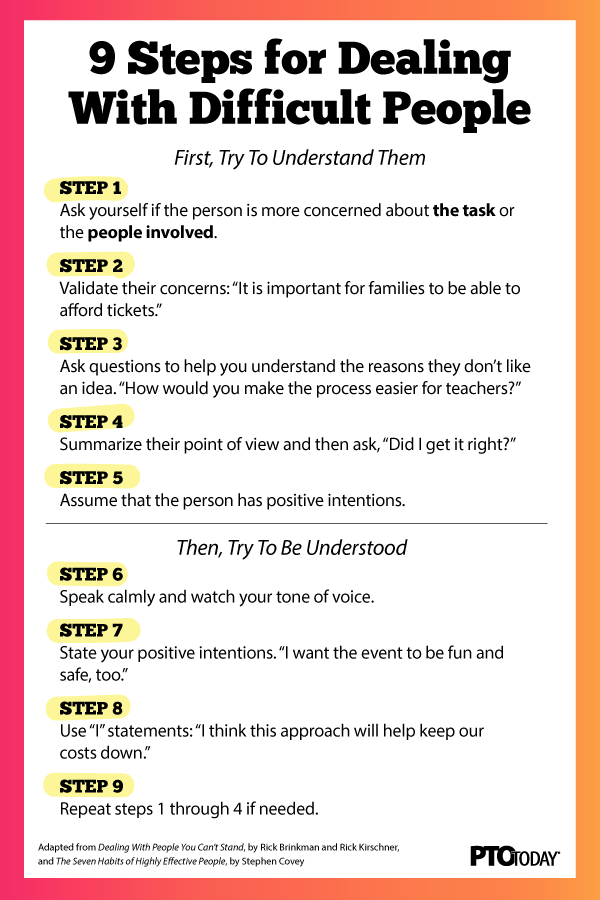We’ve all been there. There are just some people we can’t stand! Perhaps it’s a volunteer whose complaining drives you to distraction. Or it might be the person who pushes her ideas and never lets others get a word in. People like this can make your PTO leadership experience seem endless and stressful, even blocking achievement of some of your most critical goals.
Every person has their own triggers when it comes to dealing with difficult people. Those triggers stem from your background, your perspectives, and your goals in the situation at hand. But there’s good news. There are ways to deal with even the most difficult people that can bring out both their best and yours.
The first step, described by Rick Brinkman and Rick Kirschner in their book Dealing With People You Can’t Stand, is to get to know your difficult person—to know what needs that person might be trying to fulfill that cause the problematic behavior. Successful leaders listen carefully to figure out the underlying motives.
Generally, people in any given situation are task-oriented or people-oriented. Their concerns center on one of four goals:
getting the task done
getting the task done right
getting along with people
being appreciated by people
When they perceive that their concern is threatened—the task isn’t getting done, it’s being done incorrectly, people are becoming angry in the process, or they feel unappreciated for their contributions—difficult people resort to certain knee-jerk responses. Responses range from the passive, such as withdrawal, to aggressive, such as steamrolling or exploding. The difficult person often doesn’t recognize that their behavior contributes to the very problems that they’re attempting to address.
10 Types of Difficult People
Brinkman and Kirschner identify 10 different behavior patterns often exhibited by people under pressure.
The Steamroller (or Tank): Aggressive and angry. Victims can feel paralyzed, as though they’ve been flattened.
The Sniper: The Sniper’s forte is sarcasm, rude remarks, and eye rolls. Victims look and feel foolish.
The Know-It-All: Wielding great authority and knowledge, Know-It-Alls do have lots to offer, are generally competent, and can’t stand to be contradicted or corrected. But they’ll go out of their way to correct you.
The Grenade: Grenades tend to explode into uncontrolled ranting that has little, if anything, to do with what has actually happened.
The Think-They-Know-It-All: A cocksure attitude often fools people into believing their phony “facts.”
The Yes Person: Someone who wants to please others so much that they never say no.
The Maybe Person: Procrastinating, hoping to steer clear of choices that will hurt feelings, they avoid decisions, causing plenty of frustration along the way.
The Blank Wall (or Nothing Person): This person offers only a blank stare, no verbal or nonverbal signals.
The No Person: They spread gloom, doom, and despair whenever any new ideas arise, or even when old ones are recycled. The No Person saps energy from a group in an amazingly short time.
The Whiner: Whiners feel helpless most of the time and become overwhelmed by the unfairness of it all. They want things to be perfect, but nothing seems to go right. Whiners want to share their misery.
Chances are you’ve had to deal with at least a few of these characters. These aren’t odd or weird people. One of them might even be you upon occasion. Everyone has the potential to be difficult given the right, or wrong, circumstances. To understand why, return to the concept of a basic orientation toward people or task. Couple that with the typical ways people respond under pressure, on a continuum from aggressive to assertive to passive. Then add in the goals people have under different circumstances.

“Get It Done” People
According to Brinkman and Kirschner, when the goal is to “get it done,” people with a task orientation and aggressive temperament tend to dig in and become more controlling. They are the Snipers, the Steamrollers, and the Know-It-Alls. From their point of view, the rest of us are goofing off, obtuse, or just plain taking too long. The Steamroller can run over you if you get in the way. The Sniper often uses sarcasm to embarrass and humiliate at strategic moments. The Know-It-All dominates with erudite, lengthy arguments that discredit others and wear down opponents.
“Get It Right” People
When the goal is to “get it right,” people under pressure who still have a task orientation but a more passive personality become helpless, hopeless, and/or perfectionistic. They become the Whiners, No People, and Blank Walls. When Whiners are thwarted, they begin to feel helpless and generalize to the entire world. Instead of looking for solutions, they complain endlessly that nothing is right, exacerbating the situation by annoying everyone around them. No People feel more hopeless than helpless. Like A.A. Milne’s Eeyore in Winnie the Pooh, their sense of gloom carries its own cloud. Their certainty that things can never be right can pull down morale for an entire group. Blank Walls simply withdraw. They will bear no responsibility when things aren’t exactly right.
“Get Along” People
People who want to “get along” tend to focus more on the people in a situation. When they’re innately passive, they become approval-seeking Yes People, Maybe People, and sometimes Blank Walls. Yes People overcommit and underdeliver in an effort to please everyone. Their lack of follow-through can have disastrous consequences for which they don’t feel responsible because they’re just trying to be helpful. When, instead, the people they want to get along with become furious, they might offer to do even more, building their lives on what other people want and also building a deep well of resentment. Maybe People avoid conflict by avoiding any choice at all. Making a choice might upset someone, and then blame will be heaped on the person who decided. Maybe People delay choosing until the choice is made for them by someone else or by the circumstances. When Blank Walls have a people orientation, they want to avoid hurting anyone’s feelings. The old saying “If you can’t say something nice, say nothing at all” gets carried to the ultimate extreme in this case. But Blank Walls also avoid sharing anything genuine or honest about themselves and therefore never really achieve the “getting along” goal.
“Be Appreciated” People
To be appreciated is the ultimate goal of people-focused, more aggressive folks. They include the Grenade, the Think-They-Know-It-All, and sometimes the Sniper. They share attention-seeking behaviors that never accomplish what they intend. The Grenades are aggressive; they think they get no respect or appreciation. When that feeling builds to a certain point, they have an adult temper tantrum. It’s not pretty and it certainly gets attention, but blowing up never gets them to the ultimate goal of appreciation. The Think-They-Know-It-All person knows a little bit about a lot. They are so charismatic and enthusiastic that the half-facts and exaggerations can sound plausible and persuasive. When people discover that these people really don’t know what they’re talking about, the attention they seek becomes negative. The Sniper in this case is attempting to gain attention by being playful. Many people engage in playful sniping, but we all need to be careful about how it’s received. Whether it‘s funny or painful is truly in the eye of the beholder. Sometimes this kind of sniping is passed off as teasing, which can leave scars even when it’s friendly.
Responding To Difficult People
To change the course of your interactions with these difficult people, there are some simple strategies that work well with practice and patience.
In general, when your difficult person speaks, make your goal habit number five in Stephen Covey’s The Seven Habits of Highly Effective People: “Seek first to understand.” Often, unless you’re dealing with the Grenade or other overt hostility, it helps if you mirror some of the nonverbal cues the person displays. Don’t overdo, as it can look like mocking if you copy every gesture. Your aim, according to Brinkman and Kirschner, is “blending.” If you adopt some of the same traits as your person, such as a facial expression or posture, you send the message that you are “with” them, on the same wave length. Blending begins to facilitate trust. Often we do this kind of thing without even noticing that it’s happening. You also need to blend vocally with the person you’re trying to understand. Volume and pace are two examples of how to blend with another person. Blending is how you begin to build rapport with people and signal that you’re really listening. The only exception is yelling.
Also, some of what the person says needs to be repeated in a technique that counselors call “reflection.” This is a way of feeding back what you’ve heard on both feeling and content levels so that a person is sure that you’ve heard them. With no interpretation and without parroting exactly, use some of their actual words to demonstrate your understanding. How much to do it depends on the person you’re dealing with. With Steamrollers, keep reflection to a minimum. With Know-It-Alls, Yes People, and Maybe People, a great deal of reflection might be useful. This is especially true on the feeling level with Yes and Maybe People.
Get to the Real Issues
Next, ask clarifying questions to help your difficult person open up and to ensure that you fully understand all they have to say. The kinds of questions you want are open-ended, those that have more than a yes-or-no answer. They begin with what, how, where, who, when, and sometimes why—without an accusatory tone. A simple “Tell me more about...” can also serve the same purpose.
The importance of this information-gathering stage can’t be overstated. It keeps you out of a reactionary mode and helps you bring all the issues to the surface. At the same time, it shows that you really care about what the person has to say. It can also begin to defuse emotions and help the person think more logically.
Finally, still in a “seek to understand” mode, summarize what you’ve heard and confirm your understanding. Don’t assume you “got it.” Ask, “Did I get it right?” If not, keep listening until the person is satisfied that you understand.
The next step in the process has to do with attitude. Search for and acknowledge that the other person’s intentions are positive. This means giving the person you’re dealing with the benefit of the doubt.
Say What You Mean
Stephen Covey’s habit number five also has a second part. Part one, “Seek first to understand...,” is followed by part two, “...then to be understood.” Once you’ve put in the time and hard work of deep listening, the goal is to speak so that you might in turn be understood. But watch your tone of voice. The old saying applies: It’s not just what you say but also how you say it.
The next step is to state your positive intentions: “I care that people at the fun run have a chance to cool off, too. I want to make it a fun and safe day.” When the Steamroller starts to interrupt again, tactfully intervene. Repeating someone’s name over and over until they stop to listen can accomplish that end. Once the person has paused, you can insert your positive intent or a clarifying question, for instance. Then speak about the situation as you honestly see it. Use “I” statements, be as specific as possible, point out the impact of the behavior, and suggest a new behavior or option.
When you have a Blank Wall, the person who chooses the ultimate passive response instead of an aggressive response, your tactics need to be a little different. First, even though you might not feel particularly relaxed, calm yourself. It won’t help to push, so plan plenty of time. Ask the open-ended questions with an expectant tone and body language. Try to lighten things up with absurd guesses about the cause of the silence. Be careful with humor, but if you can get at least a smile, it’s a beginning.
Think Before Reacting
Difficult people are really all of us. Depending on the circumstances and our own perspectives, our behaviors can slip-slide into childish, rude, or even churlish reactions. The key is to think first instead of simply reacting when we feel pressured by time or by the competing interests and needs of others.
Thoughtful responses can help people identify their real needs and break negative behavior patterns that don’t serve anyone well. If you make a habit of listening deeply, assuming best intentions, looking for common ground, and reinforcing and expecting people’s best behavior along the way, then the difficult people in your life might come to view you as a respected friend—as opposed to one of their own most difficult people.















